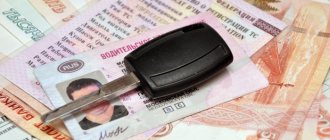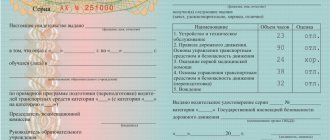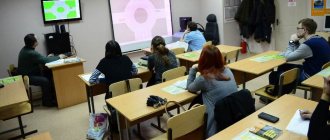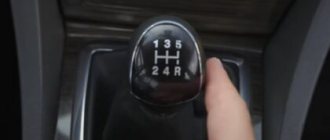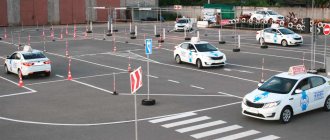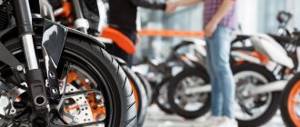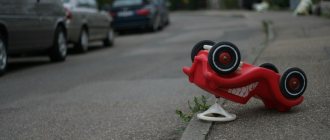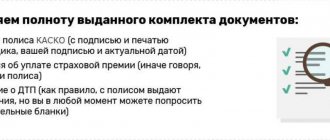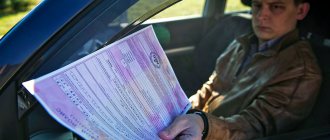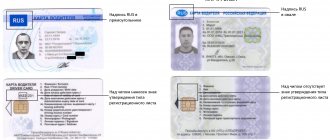12.03.2020
2 comments
108877
Do you want to become a driver, but have a vague idea of what training is like in a driving school? Then this article will help you, telling in detail about all stages of driving courses, what you need to be prepared for and what to take into account. In general terms, training in a driving school consists of only two parts - theoretical and practical. In this article we will look in detail at how training takes place at a driving school and give all the answers. If you still have questions, ask them in the comments.
Classes on site
Driving schools have a specially equipped closed area - a racing track or playground. It may belong to one school or be shared. On the site, students practice the following exercises:
- Entrance to the overpass.
- Turning around in a confined space.
- Parallel parking.
- Entry into boxing.
- Turns.
The exercises will teach the driver how to correctly navigate using mirrors, confidently move in reverse, overcome inclines or stop on them if necessary.
What do they teach in driving school?
How does the training proceed, when does the practical part begin, is it possible to master the theory online and what maneuvers are taught at the race track? Maria Loshchinina, deputy director of the Tekhnika driving school, answered these and other questions.
How long does it take to study at a driving school?
As you know, training in a driving school consists of two parts: studying theory and practical classes. The duration depends on how often the classes take place. At the Tekhnika driving school you can choose standard theory training for 2.5 months or an express course for 1.5 months. These groups practice at varying intensity, from two to four sessions per week. Students in the regular and express groups go through the same program, just at different speeds - you can choose a schedule that’s convenient for you,” said Maria. Also, students of the Tekhnika driving school can take online theory training. You will be given access to a certified Russian distance learning platform, and you will be able to take the theoretical course any day and any time of the day. You can view the prices and schedule of classes at the Tekhnika driving school here.
What do you study in theory classes?
In theoretical classes, students will learn: - Traffic rules - What are the consequences of violating the Code of Administrative Offenses of the Russian Federation - How a car works - How to provide first aid in an accident - Rules for operating a vehicle - Basics of safe driving And much more. At lectures, teachers analyze specific situations that may arise on the road, explain difficult points in traffic rules, teach how to navigate road signs and markings, etc. At the Tekhnika driving school, students are taught by teachers with more than 5 years of experience, real professionals in their field. Elena Krotova, who teaches courses “Road Rules” and “Design and Maintenance of Vehicles,” won the “Best Teacher” nomination at the competition of the best driving schools in Moscow for two years in a row. Mark Kukuev, teacher of the course “First aid in case of a traffic accident,” in addition to 8 years of teaching experience, has 37 years of work in the ambulance.
Where does practice begin?
About a month after the start of the theoretical course, students move on to practical classes. At the Tekhnika driving school, you will first be offered to practice on a training simulator - a car simulator, to develop initial vehicle driving skills. Students are admitted to it somewhere after 4-5 theory lessons, when they have already become familiar with the basic principles of traffic rules. After the training simulator, classes begin on the race track with an instructor.
This is interesting: Practical classes begin and end near the doors of the branch of the driving school where the training takes place. Students of the Tekhnika driving school do not need to get to the race track on their own; an instructor brings them there and back. Addresses of the Tekhnika driving school sites.
At the race track, students and an instructor practice basic exercises, which they will then have to take for an exam at the traffic police. These include:
- “Snake” – driving along curved markings with alternating smooth turns to the right and left. - “Turn 90 degrees” - turn right and left at an angle of 90 degrees in a limited space. -“Entering a box in reverse” – this is the practice of driving into a garage or parking space backwards. You need to drive in so as not to hit the “walls” of the box. - “Parallel parking” – parking parallel to the road, entering a parking space in reverse. - “Overpass” - you need to stop on an inclined section, and then move off so as not to roll back.
This is interesting: At the Tekhnika driving school, students are taught by instructors with more than 7 years of teaching experience. Basically, training takes place on foreign cars no older than 4 years old, both with a manual transmission and an automatic transmission.
Do classes in the city start after the race track?
Not necessary. At the Tekhnika driving school, instructors practice an individual approach to their students. If you pick it up on the fly, then after the first lesson at the race track, the instructor can begin to combine the race track and the city. If, on the contrary, you are not yet confident in your abilities, the instructor will spend more time on the circuit and explain incomprehensible points.
This is interesting: When the student has learned all the basic maneuvers on the race track, he can ask the instructor to practice driving on the roads that he plans to use in the future. For example, work on some difficult section of the road in your area or on the way to work.
Why take an internal exam at a driving school?
Without passing internal exams in theory and practice, you will not be issued a certificate of completion of a driving school. And without a document, you will not be allowed to take exams at the traffic police.
- It is recommended to take both theory and practice at the end of training, immediately before the traffic police exam. This will only benefit the student - before visiting the traffic police, he will refresh his memory of the theory, which means he will have a better chance of passing the exam the first time, notes Maria Loschinina.
What should I do if I didn’t like something in class?
For such cases, the Tekhnika Driving School has a quality control service, which is personally supervised by Deputy Director Maria Loshchinina. This is a separate number that any student can call and anonymously (or not) ask a question, report any shortcomings that he noticed, express wishes and recommendations for work. Each individual case is monitored and measures are promptly taken to ensure that the situation is resolved in favor of the student and does not happen again in the future.
- If, for example, one of the instructors did not show his best side, we say goodbye to such employees,” says Maria.
The corporate culture in the driving school is given a special place - the administration organizes pizza days for its students, timed to coincide with some event - for example, the end of training in a group. Students are also invited to participate in photo shoots or record funny videos.
Still have questions about training? You will find all the answers on the website of the driving school “Technique” . Branches of the TECHNIKA Driving School are located at the following addresses: Bibirevo metro station , Bibirevskaya, 10k1 Vodny Stadion metro station , Kronstadt Boulevard. 7A metro station Khovrino , Klinskaya 8с1 metro station Timiryazevskaya , Yablochkova 21к3 metro station Verkhnie Likhobory, Seligerskaya , Beskudnikovsky Blvd. 12с1 metro station Academician Yangelya Street, Prazhskaya , Rossoshansky Ave. 3 metro station Babushkinskaya , Letchika Babushkina 32к3
Driving around the city
The second part of learning to practice in a driving school is driving in real urban conditions. Beginners learn:
- Pay attention to markings and signs.
- Evaluate the speed and behavior of other vehicles.
- Perform turns and turns.
- Negotiate roundabouts.
- Competently follow traffic lights.
- Monitor the condition of your car.
It is not always possible for a student to find a common language with an instructor. If the relationship doesn’t work out, don’t worry: just contact the driving school management and write an application to replace the instructor.
What to do during the initial lesson
So, how do you get behind the wheel for the first time? Before the starting lesson, try to get enough sleep, don’t be nervous and calmly get to the site. It is advisable not to be late to avoid unnecessary stress.
There is a car in front of you. What should be done? If you were not at school, but in a real life situation, we would recommend that you check the condition of the wheels, and also evaluate how well you can see the road through the glass. Badly? Then it is advisable to wipe it. A driving school, as a rule, delivers a car with inflated tires and clean windows.
Sit in the driver's seat. Check if your hands are on the steering wheel with your elbows bent? No? This means that the seat position needs to be adjusted. Depress the clutch: if you have to pull with your left foot, then move the seat to make it more comfortable.
The next step is adjusting the mirrors. In the interior, you need to see the rear window and its lower edge. When viewed from the side, its lower half should be occupied by the road surface (provided that the car is parked on a flat surface). Let us add that often the exterior mirrors are slightly convex. This design feature will reduce the size of blind spots. However, this creates a small illusion: it seems that the reflected objects are further away than they actually are.
Now buckle up. That's it - you can listen to the teacher.
Additional classes
Not every student needs the standard number of hours to fully master the skills of driving a vehicle. If desired, you can take additional paid classes. Their number is limited by the financial capabilities of the student and the availability of time from him and the instructor. It is doubly advisable to take additional lessons if you had to wait a long time for the exam at the traffic police: the lessons will help refresh your memory.
The driving school prepares the candidate for the final test at the State Traffic Inspectorate, provides his documents to the inspectorate, and agrees on the deadline for each group. Now everything depends only on him. The exam consists of three stages.
Exams: at school and at the traffic police
After the driving school completes the training program, the turn of the in-school exam comes. If in some area - theoretical or practical - a cadet is clearly floundering, then the school management may not allow him to take the exam.
After successfully passing the internal exam, the graduate is allowed to take the State Traffic Safety Inspectorate. The inspection exam, like the internal one, consists of two parts - theoretical, which includes questions on knowledge of traffic rules, and practical. Passing the first allows the novice driver to the second.
It is important to know that no educational institution can reduce the educational program established by the state. But it can increase it. For example, some schools add additional classes (for an additional fee, of course), for example, in extreme driving or special courses for female drivers. Whether to go to them or not is a personal matter. However, everyone must complete the compulsory program.
FAQ:
